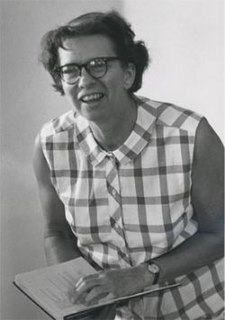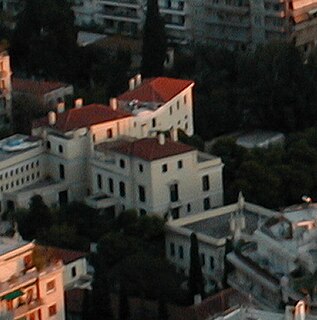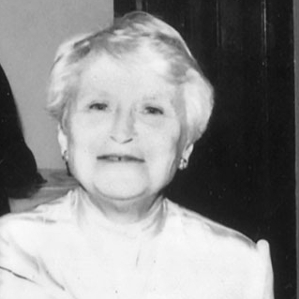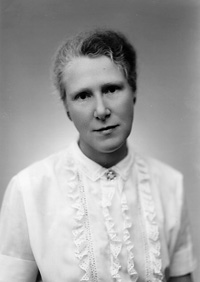Related Research Articles

The ancient Agora of Athens is the best-known example of an ancient Greek agora, located to the northwest of the Acropolis and bounded on the south by the hill of the Areopagus and on the west by the hill known as the Agoraios Kolonos, also called Market Hill. The Agora's initial use was for a commercial, assembly, or residential gathering place.

The Stoa of Attalos was a stoa in the Agora of Athens, Greece. It was built by and named after King Attalos II of Pergamon, who ruled between 159 BC and 138 BC. The current building was reconstructed from 1952 to 1956 by the American School of Classical Studies at Athens and currently houses the Museum of the Ancient Agora.

Mabel Louise Lang was an American archaeologist and scholar of Classical Greek and Mycenaean culture.
Homer Armstrong Thompson was a Canadian classical archaeologist of the twentieth century, specializing in ancient Greece. While studying for his doctorate at the University of Michigan, Benjamin Dean Meritt would introduce Thompson to the project which would occupy him for the rest of his life. The American School of Classical Studies at Athens was about to begin the excavation of the agora in Athens and Thompson was selected as a fellow of the school to aid in the project. Excavations began on May 25, 1931; Thompson would work on the excavations for the next 39 years. He was married to a fellow archaeologist Dorothy Burr Thompson.
William Bell Dinsmoor Jr. was an American classical archaeologist and architectural historian.

Dorothy Burr Thompson was an American classical archaeologist and art historian at Bryn Mawr College and a leading authority on Hellenistic terracotta figurines.

The American School of Classical Studies at Athens (ASCSA) is one of 19 foreign archaeological institutes in Athens, Greece. It is a member of the Council of American Overseas Research Centers (CAORC). CAORC is a private not-for-profit federation of independent overseas research centers that promote advanced research, particularly in the humanities and social sciences, with focus on the conservation and recording of cultural heritage and the understanding and interpretation of modern societies.
Chian wine was a product of the Greek island of Chios. It was among the most prized wines in classical antiquity and, according to Theopompus and Greek mythology, was the first red wine, then called "black wine".

An unguentarium, also referred to as Balsamarium, Lacrimarium or tears vessel, is a small ceramic or glass bottle found frequently by archaeologists at Hellenistic and Roman sites, especially in cemeteries. Its most common use was probably as a container for oil, though it is also suited for storing and dispensing liquid and powdered substances. Some finds date into the early Christian era. From the 2nd to the 6th century they are more often made of blown glass rather than clay. A few examples are silver or alabaster.

The Corinth Excavations by the American School of Classical Studies at Athens began in 1896 and have continued with little interruption until today. Restricted by the modern village of Ancient Corinth, which directly overlies the ancient city, the main focus of School investigations has been on the area surrounding the mid-6th century B.C. Temple of Apollo. This dominating monument has been one of the only features of the site visible since antiquity. Archaeologists such as Bert Hodge Hill, Carl Blegen, William Dinsmoor, Sr., Oscar Broneer, and Rhys Carpenter worked to uncover much of the site before WWII. Since then, under the leadership of directors Henry Robinson (1959-1965), Charles K. Williams II (1965-1997) and Guy D. R. Sanders (1997–present), excavation has clarified the archaeological history of the city. Investigations have revealed remains extending from the Early Neolithic period through to early modern times.
Alison Frantz was an archaeological photographer and a Byzantine scholar. With degrees in Classical and Byzantine Studies, she traveled to Greece where she joined the Athenian Agora Excavations. She was the Agora's official photographer from 1939 until 1964 and is especially renowned for her photographs of Greek sculpture. As an archaeologist, she contributed to a better understanding and appreciation of the post-classical layers of the Agora excavations with publications on the Byzantine and Ottoman material.

Sara Anderson Immerwahr was an American Classical archaeologist.

Elizabeth Gwyn Caskey was a Canadian-American classical scholar, professor, and archaeologist, known for her work in the excavations at Lerna and Kea, which are of importance to Greek prehistory. As an archaeologist she worked with her husband, Jack Caskey, on excavations where she supervised the trenches of every annual dig and their fortifications. She also wrote summaries of the excavations. After her marriage ended she excavated at Pylos. She was a Professor of Classics at Randolph-Macon College who became Professor Emeritus in 1981.
Lucy Talcott was an American archaeologist who worked on the excavations at the Ancient Agora of Athens for over twenty years. An expert on ancient Greek painted pottery, she coauthored the definitive study of Archaic and Classical household pottery.
Evelyn Lord Smithson was a noted twentieth-century scholar of classics and Classical archaeology and an expert on Bronze Age and Early Iron Age Greece.
Clairève or Claireve Grandjouan was a French-born American archaeologist.
Carol C. Mattusch is the Mathay Professor of Art History at George Mason University. She is a specialist in Greek, Roman and 18th century art.

Edward Capps, Sr. was an American diplomat, professor of Philology, and Colonel.

Josephine Platner Shear was an American classical archaeologist and numismatist, who was excavation and numismatic lead for the Agora excavations.
The New Bouleuterion is an ancient building in the city of Athens in Attica, Greece. It was located on the western side of the Ancient Athenian Agora. It is a theater with 12 rows of seats, with a seating capacity of greater than 50. A bouleuterion, sometimes translated as council house, assembly house, and senate house, was a building in ancient Greece which housed the council of citizens of a democratic city-state.
References
- ↑ "Aristeia Awards for Distinguished Alumni/Ae | American School of Classical Studies at Athens".
- ↑ "Susan Irene Rotroff". Archived from the original on 7 June 2010. Retrieved 15 April 2010.
- ↑ "New professorship: Susan Rotroff is appointed to Thurston-Van Duyn chair". Archived from the original on 17 June 2010. Retrieved 15 April 2010.
- 1 2 "AIA Lecturer: Susan Rotroff". Archaeological Institute of America. Retrieved 20 March 2016.
- ↑ "Susan Rotroff '68 Wins Top Archaeology Award, Joining a Long List of Bryn Mawr Grads So Honored". News. Bryn Mawr College. 3 February 2011. Retrieved 20 March 2016.
- ↑ "Gold Medal Award for Distinguished Archaeological Achievement". Archaeological Institute of America. Retrieved 17 February 2011.
- ↑ "10 Mar Ballot Results". Society of Antiquaries of London. 10 March 2016. Retrieved 20 March 2016.